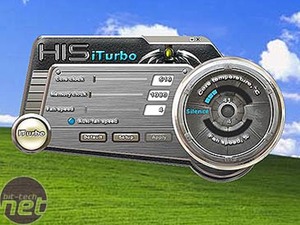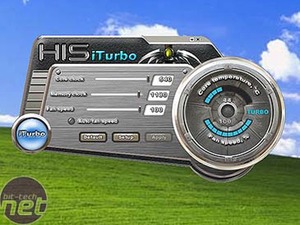Like most X850 XT Platinum Editions, this one features dual DVI outputs on the back plate and also has a VIVO port for the enthusiast who likes to spend time encoding, decoding, recording and playing video back flawlessly. With Microsoft's push towards the digital home, we are going to start seeing a lot more video cards featuring VIVO connections and also HDTV-Out ports.
 The card is a dual slot solution due to the sheer size of the IceQ II cooling system. However, do not let that put you off this video card - the solution is fantastically quiet and we've loved the cooling solution in many of our past reviews of HighTech video cards that have featured the IceQ cooling technology. Our opinion of the IceQ cooling solution has not changed in this case - we really do love this cooler.
The card is a dual slot solution due to the sheer size of the IceQ II cooling system. However, do not let that put you off this video card - the solution is fantastically quiet and we've loved the cooling solution in many of our past reviews of HighTech video cards that have featured the IceQ cooling technology. Our opinion of the IceQ cooling solution has not changed in this case - we really do love this cooler.

 Again, the bundle is another thing that we love about HighTech's video cards. While it is not as comprehensive as the likes of MSI's bundles - it is an adequate bundle with no additional fluff. There is the full version of FlatOut included, along with a disk of game demo's and trial software.
Again, the bundle is another thing that we love about HighTech's video cards. While it is not as comprehensive as the likes of MSI's bundles - it is an adequate bundle with no additional fluff. There is the full version of FlatOut included, along with a disk of game demo's and trial software.
Along with the CD bundle, there is also a wide selection of cables included - enough to satisfy everything that should be needed by the user wanting to connect this video card to a wide range of displays. There are connections for HDTV, VIVO, S-Video and Composite Out along with two DVI to VGA converters that will allow two analogue monitors to be connected to the video card if required.

 This Radeon X850 XT is a little different to other Radeon X850 XT's, in that it is guaranteed to run at Radeon X850 XT Platinum Edition clock speeds out of the box. The Radeon X850 XT is clocked at 520/1080MHz, while the Radeon X850 XT Platinum Edition is clocked at an increased 540/1180MHz – we will see how much difference this makes in a little while.
This Radeon X850 XT is a little different to other Radeon X850 XT's, in that it is guaranteed to run at Radeon X850 XT Platinum Edition clock speeds out of the box. The Radeon X850 XT is clocked at 520/1080MHz, while the Radeon X850 XT Platinum Edition is clocked at an increased 540/1180MHz – we will see how much difference this makes in a little while.
In order to achieve the clock speeds that are guaranteed out of the box, you need to install HighTech's iTurbo software, which will enable the enhanced clock speeds at the click of a mouse. Along with clock speed adjustments, the software also has adjustment for the fan speed and it also monitors the GPU's temperature. It sits in the system tray on start up, and is relatively unobtrusive, while the user interface is very easy to use.
Some users may still prefer to use third party overclocking software, and we are glad to say that it will still work. We were able to use our favourite RivaTuner tweak utility with this video card without a hitch.
In the light of some recent feedback from our forum members, we have decided to change the way that we display our results. Rather than focusing on reporting the minimum and average frame rates for every configuration, we have decided to move the focus to resolution and settings. Thus, we are displaying our "Best Playable" resolutions and settings in a table that should be easier to understand than our previous implementation. If you take the logic that the higher the resolution and in game details, the faster the video card, you will not go far wrong.
In situations where we find that two competing video cards run at the same settings, we will bring the frame rates in to the discussion of our game play experiences with each particular video card.
System Setup
AMD Athlon 64 FX-55 (operating at 2600MHz - 13x200); DFI LANPARTY nF4 SLI-DR (NVIDIA NForce4 SLI); 2 x 512MB OCZ PC5000 Platinum Series (operating in dual channel with 2.0-2-2-5 timings); Western Digital 200GB Caviar SATA 150 Hard disk drive; OCZ PowerStream 520W Power Supply; Windows XP Professional Service Pack 2; DirectX 9.0c; NVIDIA NForce4 Standalone chipset drivers, version 6.53.
Video Cards:
For the purposes of this article, we overclocked our XFX GeForce 6800 GT's to baseline GeForce 6800 Ultra clock speeds of 400/1100MHz. From now on, these cards will be referred to as GeForce 6800 Ultra to avoid confusion.
The video card drivers on the HIS Radeon X850 XT IceQ II iTurbo VIVO Edition and GeForce 6800 Ultra were left at their default settings with the exception of Vsync, which was disabled in all cases. On GeForce 7800 GTX, we also enabled Transparency Anti-Aliasing, setting it to 'Multi-Sampling', along with turning Gamma-Adjusted Anti-Aliasing on too.



Along with the CD bundle, there is also a wide selection of cables included - enough to satisfy everything that should be needed by the user wanting to connect this video card to a wide range of displays. There are connections for HDTV, VIVO, S-Video and Composite Out along with two DVI to VGA converters that will allow two analogue monitors to be connected to the video card if required.


In order to achieve the clock speeds that are guaranteed out of the box, you need to install HighTech's iTurbo software, which will enable the enhanced clock speeds at the click of a mouse. Along with clock speed adjustments, the software also has adjustment for the fan speed and it also monitors the GPU's temperature. It sits in the system tray on start up, and is relatively unobtrusive, while the user interface is very easy to use.
Some users may still prefer to use third party overclocking software, and we are glad to say that it will still work. We were able to use our favourite RivaTuner tweak utility with this video card without a hitch.
How We Tested:
Please be aware that the way we test our video cards is not a like-for-like comparison, and it is not meant to be. We decided to concentrate on finding the “Best Playable” settings - this means that we're finding the best possible gaming experience delivered on each different configuration. There are no time demos used in our evaluations - we're focusing on the real-world gaming experience, which is, ultimately what should determine your next graphics card's purchase.In the light of some recent feedback from our forum members, we have decided to change the way that we display our results. Rather than focusing on reporting the minimum and average frame rates for every configuration, we have decided to move the focus to resolution and settings. Thus, we are displaying our "Best Playable" resolutions and settings in a table that should be easier to understand than our previous implementation. If you take the logic that the higher the resolution and in game details, the faster the video card, you will not go far wrong.
In situations where we find that two competing video cards run at the same settings, we will bring the frame rates in to the discussion of our game play experiences with each particular video card.
System Setup
AMD Athlon 64 FX-55 (operating at 2600MHz - 13x200); DFI LANPARTY nF4 SLI-DR (NVIDIA NForce4 SLI); 2 x 512MB OCZ PC5000 Platinum Series (operating in dual channel with 2.0-2-2-5 timings); Western Digital 200GB Caviar SATA 150 Hard disk drive; OCZ PowerStream 520W Power Supply; Windows XP Professional Service Pack 2; DirectX 9.0c; NVIDIA NForce4 Standalone chipset drivers, version 6.53.
Video Cards:
- 1 x HIS Radeon X850 XT IceQ II iTurbo VIVO Edition – operating at its default clock speeds of 520/1080MHz using Catalyst 5.6 with Catalyst Control Center.
- 1 x HIS Radeon X850 XT IceQ II iTurbo VIVO Edition – operating at its iTurbo clock speeds of 540/1180MHz using Catalyst 5.6 with Catalyst Control Center.
- 1 x Club-3D Radeon X800 XL – operating at its default clock speeds of 394/1092MHz using Catalyst 5.6 with Catalyst Control Center.
- 1 x NVIDIA GeForce 7800 GTX – operating at its default clock speeds of 430/1200MHz using Forceware version 77.62.
- 2 x XFX GeForce 6800 GT – operating at clock speeds of 400/1100MHz in SLI mode using Forceware version 77.62 – baseline GeForce 6800 Ultra clock speeds.
- 1 x XFX GeForce 6800 GT – operating at clock speeds of 400/1100MHz using Forceware version 77.62 – baseline GeForce 6800 Ultra clock speeds.
For the purposes of this article, we overclocked our XFX GeForce 6800 GT's to baseline GeForce 6800 Ultra clock speeds of 400/1100MHz. From now on, these cards will be referred to as GeForce 6800 Ultra to avoid confusion.
The video card drivers on the HIS Radeon X850 XT IceQ II iTurbo VIVO Edition and GeForce 6800 Ultra were left at their default settings with the exception of Vsync, which was disabled in all cases. On GeForce 7800 GTX, we also enabled Transparency Anti-Aliasing, setting it to 'Multi-Sampling', along with turning Gamma-Adjusted Anti-Aliasing on too.

MSI MPG Velox 100R Chassis Review
October 14 2021 | 15:04






Want to comment? Please log in.